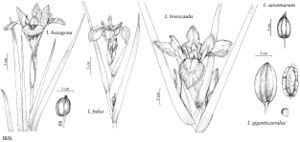Iris hexagona
Fl. Carol., 66. 1788.
Rhizomes greenish with brown leaf scars, branching from older buds quite some distance proximal to apex, forming widely scattered colonies, 2–2.5 cm diam. Stems 1–2-branched, solid, 3–9 dm. Leaves: basal stiffly erect, blade yellow-green, lightly ribbed, 8–9 dm × 2–3 cm; cauline 1–2, foliaceous, blade 1.2–2 dm, exceeding subtended flower. Inflorescence units 1–2-flowered, branch units 1-flowered; spathes lanceolate, subequal or unequal, apex acute; outer foliaceous, 15–20 cm, usually exceeding flower; inner 8–10 cm, herbaceous, with scarious margins. Flowers: perianth blue to violet, rarely white; floral tube funnelform, grooved in line with grooves of ovary, 2–3 cm; sepals spreading horizontally, obovate to oval, 8–8.5 × 4 cm, claw greenish with prominent yellow midrib which is pubescent on each side at base, apex rounded; petals erect or spreading-erect, oblanceolate to spatulate, 7–9 × 2 cm, claw veined with green; ovary roundly triangular in cross section, with wide grooves at angles and concave sides, 2–3 cm; style convex laterally from central reddish ridge, 3.5–5 cm, narrower than claw of sepals, crests erect, overlapping, semiovate to triangular, 1–5 cm, margins coarsely toothed; stigmas 2-lobed, lobes triangular or rounded-deltoid, margins entire; pedicel 2.5–3.5 cm. Capsules hexagonal in cross section, with 3 alternate sides plane, others with 2 rounded ridges with shallow groove between them, 2.5–3.5 × 2–2.5 cm. Seeds in 2 rows per locule, light brown, D-shaped or irregularly rounded, 4–6 mm, corky. 2n = 44.
Phenology: Flowering Apr–May.
Habitat: Margins of wetlands, low roadsides
Distribution

Fla., S.C.
Discussion
Iris hexagona is one of the rarest of all our native irises. We had seen herbarium specimens from seven localities in five counties of South Carolina. In searching for living plants at each of these sites we found that six of the seven are now under the water of Lake Moultrie. After extensive searching, one small population has been located at the other site, in a state park at Charleston, which is being watched carefully by the rangers of the park. A good-sized population has since been found in Dixie County, Florida, north of the small town of Shamrock, and another in neighboring Taylor County. These two populations are in the drainage system of Georgia, which in turn is fed by some of the streams from South Carolina. So far, though, I. hexagona has not been found in Georgia.
Selected References
None.
